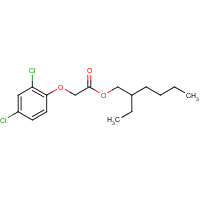2,4-D 2-Ethylhexyl ester
Agent Name
2,4-D 2-Ethylhexyl ester
CAS Number
1928-43-4
Formula
C16-H22-Cl2-O3
Major Category
Pesticides

Synonyms
2-Ethylhexyl 2,4-dichlorophenoxyacetate; 2,4-D-2-ethylhexyl; (2,4-Dichlorophenoxy)acetic acid 2-ethylhexyl ester; 2-Ethylhexyl (2,4-dichlorophenoxy)acetate; Acetic acid, (2,4-dichlorophenoxy)-, 2-ethylhexyl ester; [ChemIDplus] 2,4-D 2-EHE; [Reference #1]
Category
Herbicides, Chlorophenoxy
Description
Golden yellow liquid; [HSDB] Amber to light brown liquid with phenolic odor; [MSDSonline]
Sources/Uses
Used as selective herbicide for control of broad-leaved weeds in cereal and grass seed crops, pasture, lawn, turf, and uncultivated land; [ExPub: CPS&Q: IUCLID]
Comments
A skin and eye irritant; The esters of 2,4-D are hydrolyzed rapidly in the body to 2,4-D; Do not accumulate in mammals; Plasma half-life is about 1 day; Analysis of 2,4-D as esters and amine salts in 1982 found the esters more highly contaminated with dioxins; [HSDB] Formerly identified as the isooctyl ester; The acid form (2,4-D) is used as representative of the salts and esters due to close similarities in relative toxicities; Not irritating to skin or eyes; [Reference #2] Chlorophenoxy herbicides are possibly carcinogenic to humans (Group 2B); [IARC] See "2,3,7,8-Tetrachlorodibenzo-p-dioxin." See "2,4D."
Biomedical References
Exposure Assessment
Vapor Pressure
0.000359 mm Hg
Lethal Concentration
LC50 (rat) > 5,400 mg/m3
Reference Link #2
Adverse Effects
Hepatotoxin
Hepatoxic (a) from occupational exposure (secondary effect) or (b) in animal studies or in humans after ingestion
Diseases, Processes, and Activities Linked to This Agent
Processes
Industrial Processes with risk of exposure: